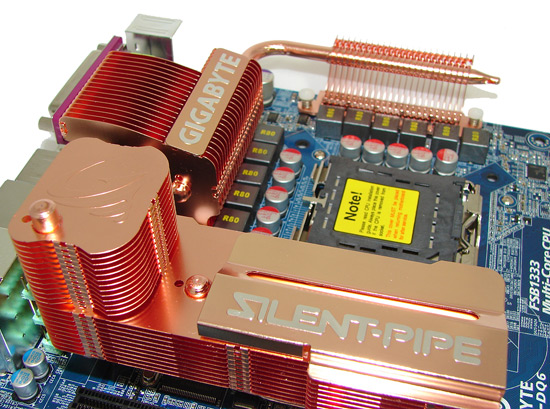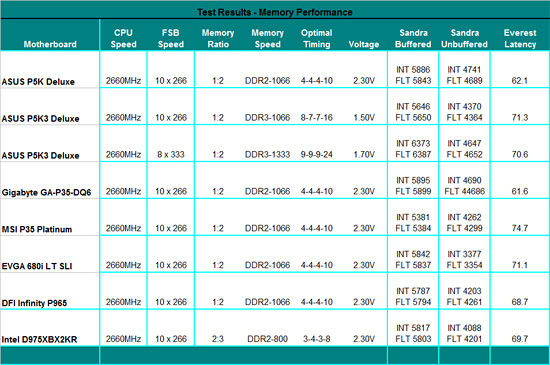Intel P35: Intel's Mainstream Chipset Grows Up
by Gary Key & Wesley Fink on May 21, 2007 3:45 PM EST- Posted in
- CPUs
Test Setup
| Standard Test Bed - CrossFire Test Configuration | |
| Processor | Intel Core 2 Duo QX6700 (2.66GHz, 8MB Unified Cache) |
| RAM | OCZ Reaper PC2-9200 (4x1GB) DDR2 4-4-4-10 Corsair CM3X1024 (4x1GB) DDR3-1066 8-7-7-16 |
| Hard Drive | Western Digital 150GB 10,000RPM SATA 16MB Buffer |
| System Platform Drivers | Intel - 8.3.0.1013 |
| Video Cards | 1 x MSI HD2900XT |
| Video Drivers | ATI 8.37.4.3 (HD2900XT Release Drivers) |
| CPU Cooling | Tuniq 120 |
| Power Supply | OCZ ProXStream 1000W |
| Optical Drives | Plextor PX-760A, Plextor PX-B900A |
| Case | Cooler Master CM Stacker 830 |
| Motherboards | Intel D975XBX2KR (Intel 975X) - BIOS 2692 ASUS P5K Deluxe (Intel P35) - BIOS 0304 ASUS P5K3 Deluxe (Intel P35) - BIOS 0011 MSI P35 Platinum (Intel P35) - BIOS 7345P01 Gigabyte P35-DQ6 (Intel P35) - BIOS F4 DFI Infinity P965 (Intel P965) - BIOS 424 EVGA 680i LT SLI (NVIDIA 680i LT) - BIOS P04 |
| Operating System | Windows Vista 64-bit Ultimate |
| . | |
Test conditions were maintained the same, as much as possible, over the platforms tested. Our game tests were run at settings of 1280x1024 HQ to ensure our GPU was not a bottleneck during testing. We will provide CrossFire results in our upcoming P35 roundup but preview performance numbers are available in this article.
All results are reported in our charts and color-coded for easier identification of results. We utilize new drive images on each board in order to minimize any potential driver conflicts. Our 3DMark results are generated utilizing the standard benchmark resolution for each program. We run each benchmark five times, throw out the two low and high scores, and report the remaining score. All results are run at stock speeds for this article although we will provide overclocked results in the next article.
Our choice of software applications to test is based on programs that enjoy widespread use and produce repeatable and consistent results during testing. Microsoft Vista has thrown a monkey wrench into testing as the aggressive nature of the operating system to constantly optimize application loading and retrieval from memory or the storage system presents some interesting obstacles. This along with the lack of driver maturity will continue to present problems in the near future with benchmark selections. Our normal process was to change our power settings to performance, delete the contents of the prefetch folder, and then reboot after each benchmark run. This is a lengthy process to be sure, but it results in consistency over the course of benchmark testing. All applications were run with administer privileges.

The test results we will present today are preliminary. What do we mean by this? Although the boards we are reviewing are full retail kits, their BIOS tuning continues at a rapid pace before the "official" launch on June 4th. Over the course of the last week we have tested numerous BIOS releases from each manufacturer and we've seen positive steps along the way. We honestly thought this preview would be a cake walk for ASUS until Gigabyte/MSI provided their latest BIOS releases that improved the performance of the boards up to 9% in certain areas.
We are also using early DDR3-1066 samples with memory settings at 8-7-7-16 for 1066 scores and 9-9-9-24 for DDR3-1333 results. We just received lower latency DDR3-1333 modules and will update our results in the roundup. On a side note, ASUS provided us a new BIOS for their P5K3 board that enables 1T command rates at DDR3-1066. Early testing has shown performance improvements up to 4% in memory sensitive applications. ASUS is continuing to work on the command rate timings and hopes to have 1T settings ready when low latency DDR3-1333 hits the market shortly. Expect to see an exclusive on this memory and BIOS in the next few days.
Our Intel Intel D975XBX2KR will be at a slight disadvantage, but with memory speeds set to DDR2-800 we were able to run timings at 3-4-3-8 without issue. We did not include extensive overclocking results for the CPU or memory side as time did not permit us to run each processor series on each board for the full test suite. We received seven boards late last week and will have results on several of those along with full overclocking results before Computex starts. We will also compare P35 1333/1066 DDR2 against P965 1333/1066 at the same time. Our DFI Infinity P965 is the fastest P965 board in our labs and as such is a good match for comparison.
Memory Performance
 |
| Click to enlarge |
We switched to a 4GB memory configuration for this article and future motherboard tests. The P35 chipset proves to have the fastest memory performance and best latencies at stock speeds provided the BIOS is tuned properly. We still find the 975X to offer some of the fastest memory performance when overclocked provided you can change strap settings and have very good RAM.
We noticed an 11% difference in unbuffered memory speeds and a 7% difference in latencies on the ASUS P5K Deluxe board when comparing auto to manually adjusted BIOS settings using the same standard 4-4-4-10 memory timings. Our other boards are tuned to the best possible performance that still allows the board to complete our benchmark test suite. We did not compare DDR2-1333 to DDR3-1333 for the simple fact that we currently do not have any DDR2 memory capable of 1333 speeds in a stable manner. However, we do expect DDR2-1333 RAM later this summer.










58 Comments
View All Comments
Wesley Fink - Monday, May 21, 2007 - link
Early boards will be expensive, just like always. The prices will likely drop to the same levels as current P965 boards they replace, with a broad range for P35 boards from basic to "Asus Commando" level gaming boards. It is too early to be discouraged.Comdrpopnfresh - Tuesday, May 22, 2007 - link
I'm willing to bet we'll see them replacing the older boards quickly too. If intel and other manufacturers really want DDR3 to go through, you'll see DDR2 boards disappearing quickly. Its like what happened to s939. Basically the same chips were used for AM2, but the boards and chips quickly dried up and disappeared. The same can be said or PCI-e. In the beginning there wasn't much of a real world benefit, just the theoretical bandwidth increase. Because developments in AGP ceased, we might never know if the switch was necessary.Comdrpopnfresh - Monday, May 21, 2007 - link
If something other than NAND flash could be used, it would be very interesting to see a pci-e 1x board that can house DDR2 memory for use in turbo memory. That way, when people upgrade their ~35 boards to DDR3 when performance and price changes, the DDR2 can be used further. This would make a lot of sense too, because unlike Gigabyte's i-RAM device and logical ramdrives, the high speed, low latency properties of RAM could be used for turbo memory as a way around the 8gb limit of RAM on these cards. And since they are not used for storage, merely access, no redundancy on power supply is needed as with the i-RAM. Someone should start development on this...Comdrpopnfresh - Monday, May 21, 2007 - link
Why would the TDP on the P35 higher if it has no integrated video? Will third-party manufactures implement their own SLI into the P35 given that the reference model only had on x16 pci-e slot? Also, when can we expect to see pci-e2 and more than 4 dimm slots on intel mobos?yacoub - Monday, May 21, 2007 - link
Including a jumper to change the strap setting for the fsb is a nice feature on the MSi board. A little disappointed in the memory comparison test that that board had the lowest bandwidth and most latency. Is that something BIOS updates can improve or is that generally hardware (i.e. board design related)?Gary Key - Monday, May 21, 2007 - link
It is all BIOS tuning in regards to the MSI board. Our first results with the board had the memory performance being equal to the 945P boards. Two BIOS releases later and the improvements have been remarkable. I think MSI is about two BIOS spins behind ASUS and Gigabyte now. Gigabyte finally caught up but ASUS still has the better feature set and options in my opinion.michal1980 - Monday, May 21, 2007 - link
hardocp, seems to take a 180 different outlook on these boards. so werid.skaterdude - Monday, May 21, 2007 - link
What's so weird? Kyle is an extension of AMD's marketing department. He has not cared for Intel in a very long time, at least since he was caught cheating on some Intel benchmarks and was hung out to dry for it. Personally, it is alright to have a favorite company to root for but to do so in such an open and bias way is wrong if you are not running a company specific website. I would not have an issue at all if it was called HardAMD, at least you know what you are viewing is not tainted by free trips, booze, products, and general hostility against a company.
Back on subject....The P35 is a nice upgrade and it may not set the world on fire but it appears Intel listened and improved on a chipset they could have let ride for a lot longer. DDR3 will be interesting and at least the kinks will be worked out by the time X38 and the new processors get here. If I had not already bought a 965 board then P35 would have been the one. I am still miffed about not having a native IDE port as JMicron just plain sucks most of the time.
strikeback03 - Tuesday, May 22, 2007 - link
the P35 does not have native IDE either, and why use an IDE drive anyway?Spoelie - Monday, May 21, 2007 - link
ahum, AMD biased? After reading some of their recent gpu reviews, I thought it was the other way around... Check yourselfanyway, not a worthy upgrade, but a worthy new board. Which is what you could reasonably expect.